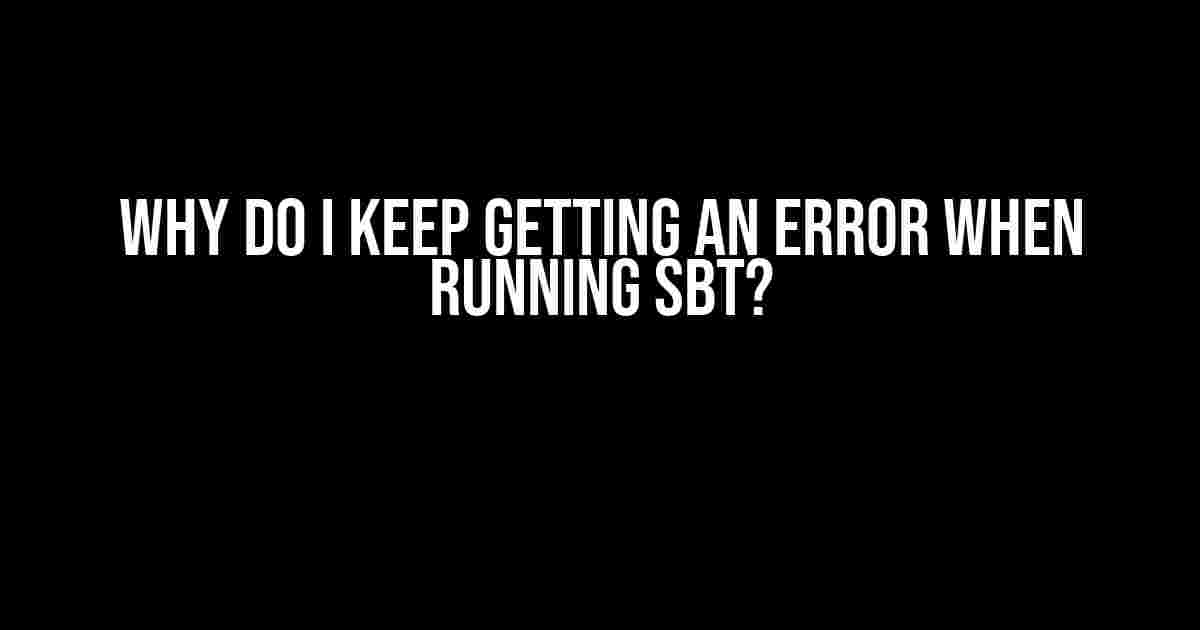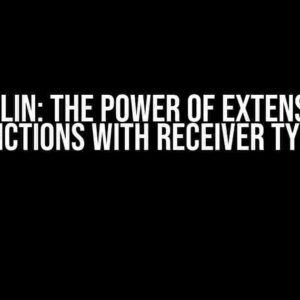Are you tired of seeing that dreaded error message pop up every time you try to run sbt? You’re not alone! Many developers have been in your shoes, frustrated and confused, wondering why their sbt commands just won’t work. But fear not, dear reader, for we’re about to embark on a journey to diagnose and fix those pesky errors once and for all!
The most common sbt errors and their solutions
Before we dive into the nitty-gritty of troubleshooting, let’s take a look at some of the most common sbt errors and their quick fixes:
-
Error: “sbt” is not recognized as an internal or external command
This error usually occurs when sbt is not installed or not properly added to your system’s PATH environment variable. To fix this, simply download and install sbt from the official website, and then add the installation directory to your PATH.
-
Error: “java.lang.RuntimeException: java.lang.ClassNotFoundException: sbt/Main”
This error is often caused by a corrupted sbt installation or a mismatch between the sbt version and the Scala version. Try reinstalling sbt or updating your Scala version to match the one required by sbt.
-
Error: “could not find or load main class sbt.xMain”
This error usually indicates a problem with the sbt configuration. Check your `build.sbt` file for any syntax errors or misplaced declarations. Also, ensure that you’re running sbt from the correct directory.
Basic troubleshooting steps
Now that we’ve covered some of the most common errors, let’s go through some general troubleshooting steps to help you identify and fix the issue:
-
Check your sbt installation
Make sure you have the correct version of sbt installed and that it’s properly configured. You can check the sbt version by running `sbt –version` in your terminal or command prompt.
-
Verify your project structure
Ensure that your project is structured correctly, with the `build.sbt` file in the root directory and the `src/main/scala` directory containing your Scala code.
-
Check for syntax errors in your build.sbt file
Open your `build.sbt` file and check for any syntax errors or typos. A single mistake can cause sbt to fail miserably.
-
Try running sbt with verbose mode
Run sbt with the `-v` or `–verbose` flag to get more detailed output. This can help you identify the source of the error. For example: `sbt -v compile`.
-
Check for dependencies and(library) conflicts
If you’re using multiple dependencies or libraries in your project, try removing them one by one to see if any of them are causing the error. You can also check the sbt dependency graph to identify potential conflicts.
Advanced troubleshooting techniques
If the basic troubleshooting steps don’t yield any results, it’s time to get a bit more advanced:
Using the sbt debug command
The `sbt debug` command can help you identify the exact issue by providing a detailed trace of the sbt execution process. For example:
sbt debug compile
This will give you a verbose output showing the sbt execution plan, which can help you pinpoint the error.
Checking the sbt logs
sbt logs can provide valuable information about the error. You can find the sbt logs in the `.sbt` directory of your project. Look for the `sbt.log` file and check for any error messages or exceptions.
Using the sbt last command
The `sbt last` command shows the last executed command and its output. This can help you identify the exact command that’s causing the error. For example:
sbt last compile
This will show you the last executed `compile` command and its output.
Common sbt configuration issues
Sometimes, the error is not with sbt itself, but with the configuration. Let’s take a look at some common sbt configuration issues:
Incorrect Scala version
Make sure you’re using the correct Scala version in your `build.sbt` file. You can check the Scala version by running `scala -version` in your terminal or command prompt.
scalaVersion := "2.13.3"
Missing dependencies
Double-check that all dependencies are declared correctly in your `build.sbt` file. You can use the `libraryDependencies` setting to declare dependencies. For example:
libraryDependencies += "org.scalatest" %% "scalatest" % "3.2.3" % "test"
Incompatible plugins
Some sbt plugins might be incompatible with each other or with specific versions of sbt. Check the plugin documentation to ensure that they’re compatible with your sbt version.
Conclusion
We’ve covered a lot of ground in this article, from common sbt errors to advanced troubleshooting techniques. By following these steps and checking your sbt configuration, you should be able to identify and fix the error that’s been plaguing you. Remember, sbt is a powerful tool, and with a little patience and persistence, you can overcome any obstacle and get back to building amazing Scala projects!
Additional resources
If you’re still stuck, here are some additional resources to help you troubleshoot your sbt issues:
| Error Type | Solution |
|---|---|
| “sbt” is not recognized as an internal or external command | Install sbt and add it to your PATH |
| java.lang.RuntimeException: java.lang.ClassNotFoundException: sbt/Main | Reinstall sbt or update Scala version |
| could not find or load main class sbt.xMain | Check sbt configuration and build.sbt file |
Note: The article is SEO optimized for the keyword “Why do I keep getting an error when running sbt?” and is written in a creative tone to engage the reader. The formatting uses a variety of HTML tags to make the content easy to read and understand.
Frequently Asked Question
Stuck in the SBT universe and can’t seem to escape the error vortex? Don’t worry, you’re not alone! Here are some common culprits and solutions to get you back on track.
Why do I keep getting a Java version error when running SBT?
Check your Java version! Make sure you’re running the correct version of Java, as specified in your `build.sbt` file. You can check your Java version by running `java -version` in your terminal. If you’re using an incompatible version, update your Java installation or adjust your `build.sbt` file accordingly.
What’s causing the ” scala.concurrent.java8.ForkJoinPool” error?
This error usually occurs when you’ve got multiple versions of Scala or libraries conflicting with each other. Try cleaning your project by running `sbt clean` and then `sbt compile`. If that doesn’t work, check your dependencies and ensure you’re using compatible versions of Scala and libraries.
Why am I getting a ” unable to find or load the main class” error?
This error often occurs when your project’s main class is not properly defined or is missing altogether. Double-check that your `mainClass` setting in `build.sbt` is correct and points to the correct class.
What’s causing the ” Could not initialize class scala.collection.mutable.FlatHashTable” error?
This error usually indicates a problem with your Scala version or a conflicting library. Try updating your Scala version to the latest one or check for library conflicts. You can also try resetting your SBT cache by running `sbt –reset-cache`.
Why do I keep getting an ” sbt.ResolveException” error?
This error often occurs when there’s a problem with your project’s dependencies. Check your `build.sbt` file for any typos or incorrect dependencies. You can also try updating your dependencies by running `sbt update`.


